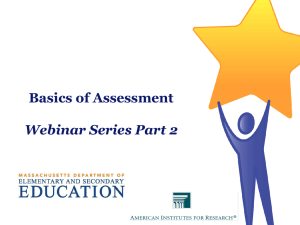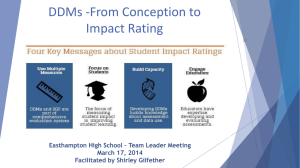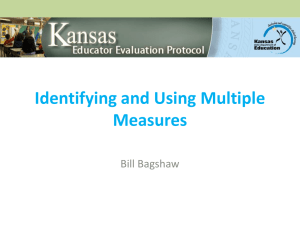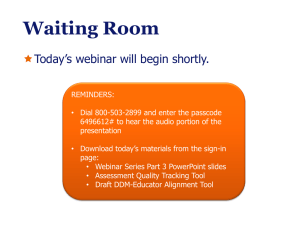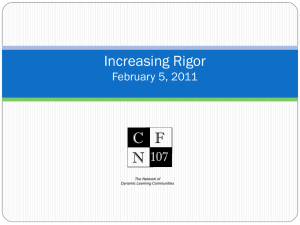District-Determined Measures Basics Of Assessment PowerPoint
advertisement
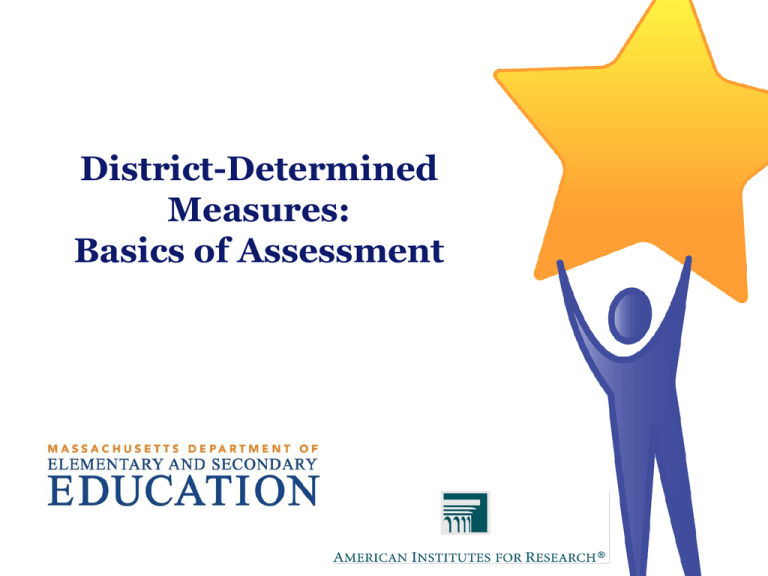
District-Determined Measures: Basics of Assessment Agenda District Determined Measures Assessment Overview Types of Assessments Alignment Assessment Components Assessment Quality 2 District Determined Measures Measures of student learning, growth, and achievement related to the Massachusetts Curriculum Frameworks, Massachusetts Vocational Technical Education Frameworks, or other relevant frameworks, that are comparable across grade or subject level district-wide. 3 District-Determined Measures Implementation Rollout: By September 2013, all districts will identify and report to ESE a district-wide set of student performance measures for: Early grade literacy (K-3) Early grade math (K-3) Middle grade math (5-8) Writing to text (9-12) Non-traditionally assessed subjects (K-12) Massachusetts Department of Elementary and Secondary Education 4 District-Determined Measures Implementation Rollout: By June 2014, all districts will identify and report to ESE a district-wide set of student performance measures all grades and subjects. 5 Massachusetts Department of Elementary and Secondary Education District-Determined Measures DDMs should measure growth, not just achievement. Assessments should be administered across all schools in the district where the same grade or subject is taught. (Common Assessments) Districts must use measures of growth from state assessments where they are available. Only applicable to fewer than 20% of educators 6 Massachusetts Department of Elementary and Secondary Education District Determined Measures Borrowing intact measures (e.g., a scoring rubric for a performance task) available to the public at no cost do not require permission to use closely align to the local curriculum 7 District Determined Measures Building district creates a customized test for a particular grade or course using: released items item pools sample items 8 District Determined Measures Buying: commercial assessments closely aligned with local curricula purchased from a vendor 9 District Determined Measures Pre- and post-assessments Approved commercial assessments Portfolios Capstone projects 10 The Opportunity Identifying DDMs can be the impetus for broadening and strengthening the district’s assessment practices. DDMs will provide educators with useful data that will help them improve both student outcomes and their instructional practices. DDMs will yield data educators can use throughout the 5-step evaluation cycle. 11 Agenda District-Determined Measures Assessment Overview Types of Assessments Alignment and Rigor Assessment Components Assessment Quality 12 Assessment Overview Assessment is a general term that refers to the process of gaining information about student learning Process includes administration procedures, scoring, reporting, etc. A DDM is an assessment Instrument refers to a specific type of data collection tool or mechanism used in an assessment process There are many types of instruments A test is one example 13 Value of Good Assessment Better teaching Better learning and greater confidence Better student outcomes Better opportunities in life Better assessment 14 Assessment Approaches Indirect Gather information from sources other than actual samples of student work Direct Gather information from actual samples of student work 15 Agenda District-Determined Measures Assessment Overview Types of Assessments Alignment and Rigor Assessment Components Assessment Quality 16 Types of Assessments On-Demand Performance, Project Summative Assessments: EOC, EOY, Interim, Capstone Portfolio Hybrid 17 On-Demand Assessments An assessment that takes place at a predetermined time and place, usually under standard conditions for all students being assessed SAT MCAS unit tests final exams 18 Performance/Project Assessments based on observations of behaviors or based on work performed on a complex activity Natural vs. Artificial Unstructured vs. Structured Participant vs. External Observer Self-rated vs. Other-rated (teacher, peer, observer) 19 Portfolio A purposeful and systematic collection of student work Should include: student participation in the selection of portfolio content, the criteria for selection are aligned to standards and grade-level expectations through a rubric or other scoring device, the criteria for judging merit, and evidence of student self-reflection May include both finished work (Product) and work in progress (Process) May focus on one or more curricular areas 20 Hybrid Assessment An on-demand assessment that combines two or more types of assessments Usually a paper-and-pencil or online test with a performance, portfolio, or project assessment 21 Agenda District-Determined Measures Assessment Overview Types of Assessments Alignment and Rigor Assessment Components Assessment Quality 22 Alignment and Rigor Alignment -extent to which the assessment aligns with curriculum as expressed in the curriculum map Rigor -level of cognitive complexity of the item or of a set of items Bloom’s revised taxonomy 23 Alignment DDMs reflect key learning objectives by grade and content area in the district’s curricular maps. 24 Alignment Identify the key content you want to assess Standards • (Mathematics.G.SRT.3.08) Use trigonometric ratios and the Pythagorean Theorem to solve right triangles in applied problems Learning objectives • Students will correctly apply Pythagorean Theorem when prompted. • Students determine when to correctly apply trigonometric ratio models. 25 Rigor – Revised Bloom’s Taxonomy Creating Higher Order Evaluating Analyzing Applying Lower Order Understanding Remembering 26 Rigor – Revised Bloom’s Taxonomy Higher Order Lower Order Understanding 27 Rigor – Revised Bloom’s Taxonomy True/False: Will a set of skis that are 6’ (six feet) high fit into an empty closet with the following dimensions? Higher Order Dimensions: 3 Feet Wide 3 Feet Deep 5 Feet High Applying Lower Order 28 Agenda District-Determined Measures Assessment Overview Types of Assessments Alignment and Rigor Assessment Components Assessment Quality 29 Assessment Components Table of Test Specifications Administration Protocol Instrument(items) Scoring Method Documentation (reporting) 30 Table of Test Specifications Grade 10 Mid-Unit Math Test Cognitive Complexity Mathematics.G.SRT.3.08 LO #1: Students will correctly apply Pythagorean Theorem when prompted. LO: #2 Students determine when to correctly apply trigonometric ratio models. SubTotal LowerOrder HigherOrder Subtotal 25% 30% 55% 25% 20% 45% 31 50% 50% 100% Administration Protocols Often found in Administration Manuals Needed to ensure all students have a fair opportunity to demonstrate what they know and can do in the assessment Proctoring directions Security provisions (not overly familiar to examinees and proctors) Student accommodations 32 Items Selected Response True–False Multiple Choice Matching Constructed Response Short answer Restricted constructed response Extended constructed response (includes essay) Portfolio item Performance item 33 Selected Response Item The Stem and Stimulus: Succinctly describes the problem for examinees. The Options: Provide a correct answer (C) and incorrect answers that will “distract” examinees who do not know the material. 34 Constructed Response Item MCAS Test Question Grade 8 2012 Question 10 35 Scoring Items Scoring objective items Scoring key or short guide Based on clearly defined scoring key and set of scoring rules Limits error variance Scoring subjective items Longer scoring guide with rubrics or calibrated scoring papers Based on personal judgment Increases potential for error 36 Sample Holistic Rubric In 200 words or less, describe how you would explain to a home owner the concept of eminent domain and how it is related to the Fifth Amendment. Sample Analytic Rubric MCAS Test Question Grade 8 2012 Question 10 Calibrated Scoring Paper 39 MCAS Test Question Grade 8 2012 Question 10 Simple Score Report Student 1 2 3 4 5 6 Item1 0 0 1 2 2 1 Pre and Post Performance Assessment PreTest PostTest Item2 Item3 Item4 Item1 Item2 Item3 0 0 0 0 0 0 1 0 0 1 4 0 2 0 1 1 4 2 2 0 1 3 4 1 1 1 0 3 2 2 0 0 3 1 1 1 Item4 0 1 3 2 1 3 40 Agenda District-Determined Measures Assessment Overview Types of Assessments Alignment and Rigor Assessment Components Assessment Quality 41 Assessment Quality Reliability Validity Fairness and Non-Bias Item Quality Feasibility 42 Reliability Degree of consistency in measurement We want to have confidence that scores are stable Example: Weighing yourself on a scale 43 Reliability Four typical approaches Internal consistency Test-retest Alternate forms or split-half Inter-rater agreement Reliability coefficients are estimated using statistical formulas We cannot “see” reliability Ranges from 0 (no reliability) to 1 (perfect reliability) 44 Validity Validity refers to the validity of inferences made about assessments or based on assessment data Gives you confidence that what you say about student assessment scores and therefore about students is justified Example: Weighing yourself on two different kinds of scales 45 Validity Based on Content For existing measures, districts review content in instrument and judge whether it matches curriculum (review of alignment and rigor) Grade 10 Mid-Unit Math Test Cognitive Taxonomy Lower- Higher- Subtotal Order Order Mathematics.G.SRT.3.08 Will a set of skis that are 6’ (six LO #1: Students will 25% True/False: 30% 55% feet) high fit into an empty closet with the correctly apply Pythagorean following dimensions? Theorem when prompted. LO: #2 Students determine 25% Dimensions: 20% 45% when to correctly apply 3 Feet Wide trigonometric ratio models. 3 Feet Deep SubTotal 50% 50% 100% 5 Feet High 46 Validity Based on Relationships Assessment should show: Moderate to strong and positive correlations with similar instruments/outcomes Low positive or even negative correlations with dissimilar instruments/outcomes Correlation = A statistical technique that is used to measure and describe the strength and direction of the relationship between two variables Range from -1 to +1 47 Consequential Validity Realization of benefits Student learning Teacher improvement Minimization of negative consequences Poor student or teacher attitudes toward the assessment or assessments generally Limiting instruction only to the content covered in the instrument Improper use of scores 48 Fairness and Non-Bias Fairness All examinees have equal opportunity to demonstrate knowledge on assessment Non-Bias Students with similar ability receive similar scores, regardless of group membership 49 Item Quality Item quality is a key to assessment quality We typically look at three things: Difficulty Ensure a range of difficulty (e.g., easy, medium, hard) in items Average difficulty aligns to assessment purpose and target population Discrimination Ensure that people who got higher scores on the instrument overall tend to get higher scores on that item Guessing Reduce guessing by writing good response options for selected response items (e.g., multiple-choice items) 50 Feasibility Cost Technology E.g., Paper and pencil, online, adaptive Assessment length Reports E.g., access to, ability to interpret Accommodations and accessibility 51 Your work today Begin assessing your department’s level of readiness to implement DDMs Do you have assessments you believe meet the criteria to be a DDM? Do you have assessments that require some adjustment to meet the criteria to be a DDM? Do you have to create new assessments? Do your assessments measure a year of growth? Do the assessments have rigor? Are your assessments valid and reliable? 52 Massachusetts Department of Elementary and Secondary Education Discussion Guide #1 Based on the presentation, identify some basic “do’s and don’ts” about assessment that you need to consider when selecting or building a DDM. 53 Discussion Guide #2 Take a minute to jot down sources of existing assessments that might be used for DDMs. 54 Discussion Guide #3 Think about the potential DDMs you just listed. Which one shows the best alignment to the curriculum? Do they also have the appropriate degree of rigor? How can it be improved? 55 Discussion Guide #4 Assessments are composed of: • • • • • Table of Test Specifications Administration Protocol Instrument Scoring Method Documentation Reflect for a moment on one of the assessments you’re considering for use as a DDM. Identify the components you have in place and those you’d want to develop. 56
